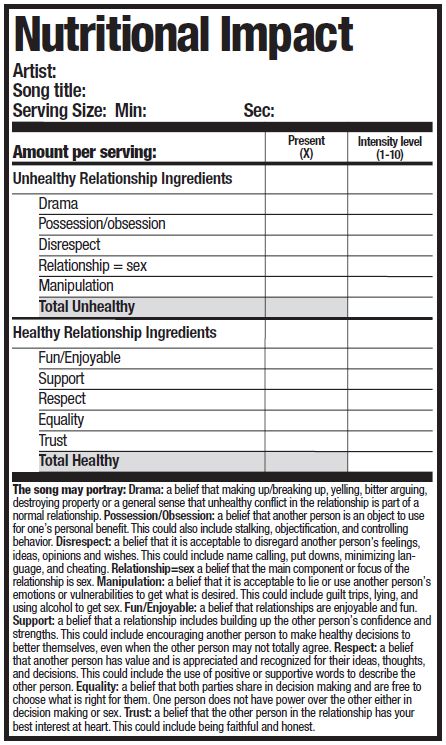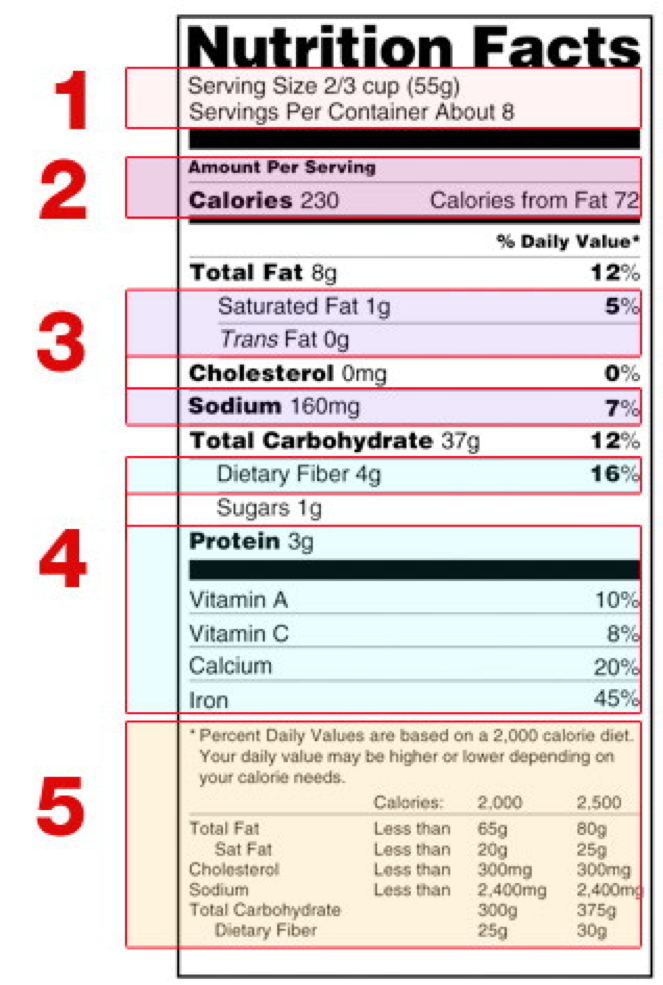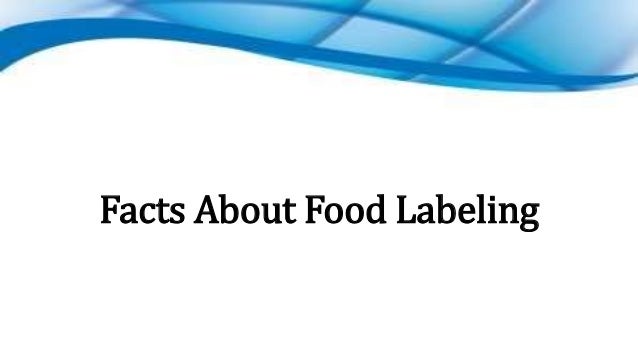43 fun facts about food labels
The Science Behind Calories and Nutrition Facts Labels ... The calorie number we see on food labels refers to a kilocalorie (kcal), which is also known as a large calorie or a food calorie. A kilocalorie is 1 000 calories. A kilocalorie is 1 000 calories. One kilocalorie is the amount of energy it takes to heat one kilogram of water one degree Celsius at sea level. Nutrition Facts and Food Labels - Eatright.org Get to know the basics of the Nutrition Facts label, and understand the parts and pieces, from serving size, total calories and fat to percent of Daily Values. Teach Your Teen about Food Panels If decoding the information on a food package is a challenge for adults, think of how hard it is for teens who are just beginning to make choices for ...
Food Labels - Nutrition.gov Food Labels Food labels can help you make healthy choices when buying food in grocery stores or restaurants. Labeling Organic Products USDA, Agricultural Marketing Service, National Organic Program Learn about organic foods, requirements, and how they are labeled. Calories on the Menu HHS, Food and Drug Administration

Fun facts about food labels
Get the Facts on Dietary Guidelines MyPlate and Food Labels New food labels highlight important information, such as the amount of vitamin D, potassium and added sugars. Nutrient reference values, expressed as % Daily Values, which help you see how a specific food fits into your overall daily diet. 8 Surprising Facts About Nutrition Labels - Back to the ... Food labels break down total fat into saturated fats and trans fats (stay away from these), and total carbohydrates are broken down into dietary fibers (the good stuff) and sugars (the not so good stuff). 4. %DV Food Labels | CDC If you eat the whole thing, you are eating 8 times the amount of calories, carbs, fat, etc., shown on the label. Total Carbohydrate shows you types of carbs in the food, including sugar and fiber. Choose foods with more fiber, vitamins, and minerals. Choose foods with lower calories, saturated fat, sodium, and added sugars. Avoid trans fat.
Fun facts about food labels. An In-Depth Look at the History of Food Product Labels When you look back at the origin of food labels, the government created these labels for consumer safety rather than marketing. Unfortunately, false advertising and fake ingredients plagued consumerism in the early 1900s. To stop health reactions from falsely advertised products, Congress signed the Pure Food and Drug Act into Congress in 1906. Food Labels 101: Understanding the Nutrition Facts Label ... Nutrition labels are based on a daily 2,000 calorie diet. Depending on your age, gender and activity level, you may need to consume more or less than 2,000 calories per day, so keep this in mind when viewing each label. Now let's take a look at the parts of the nutrition facts label and break it all down. Anatomy of a Nutrition Facts Label 14 Bizarre Ingredients Hidden in Your Food Labels - The ... Food labels contain so many different information - from calorie count, nutritional information to ingredients. So what is the secret? Well, some of the ingredients that we consume daily in our favorite food come from the strangest places. For example, bread contains an ingredient that is derived from human hair. Yuck! Food Labels Facts Tool- Interactive Food Label Reader, How ... Our interactive Food Label Reader is a quick tool and nutrition tutorial for parents. Parents love our interactive food labels tool but is useful for anyone wants to understand food labels, count their calories, reduce high fats foods and sugar and have nutrition facts to choose healthier foods. Learn how to understand food labels, nutritional information and avoid false marketing claims.
From the Label to the Table! - Kids Environment Kids ... Products labeled "light" or "lite" must have 1/3 fewer calories or 1/2 the fat of the foods to which they are compared. "Light" also can mean that salt has been reduced by 1/2. Look for foods with lower levels of saturated fats. The sodium level tells you how much salt is in food. Look for products that have more fiber and less sugar. Food Regulation Facts - What your label doesn't tell you ... It provides access to statistics and facts sourced from FDA, CDC, AAFCO, PFI and other sites. Often times these statistics and facts contradict information published by these same organizations. FRFA provides AAFCO meeting agenda's to members prior to the meetings, allowing members the opportunity to contribute to the agenda at the meetings. 3 Things to Know About Your Food's Nutrition Label | Live ... One manufacturer may count six ounces as a serving, while the other only counts four. 2. "Percent Daily Value" is based on a 2,000-calorie daily diet. This means that the percentages serve as a... Get the Facts: Know Your Food Label - Health Powered Kids Locate the Nutrition Facts label for your food item (s). Find the Serving Size and Servings Per Container. Remember: all of the nutrition information on the label is based on one serving of the food. A package of food often has more than one serving! Find the calories. They are the "fuel" our bodies need for our daily activities.
100 Mind-Blowing Facts About Food - Eat This Not That It will appear on your food label under the guise of "confectioner's glaze." 13 Nutmeg can cause hallucinations Shutterstock Too much of a spice can be a bad thing, and nutmeg is no exception. If you have two or more teaspoons of the spice, it can actually cause hallucinations! 14 Cucumbers are mostly water Shutterstock The Evolution of Food Labels: A Timeline | 48HourPrint The Food, Drug, and Cosmetic Act took effect, requiring any artificial flavoring, coloring, or chemical preservative to be listed on the food label. It also states that "a food shall be deemed to be misbranded if its labeling is false or misleading in any particular." 1962 How to Understand and Use the Nutrition Facts Label | FDA Dietary fiber, vitamin D, calcium, iron ad potassium are nutrients on the label that Americans generally do not get the recommended amount of. They are identified as nutrients to get more of.... Facts on Food Labeling And What You Should Know ... Food labeling is a requirement for most prepared foods, like: Cereals Breads Frozen foods Canned foods Desserts Snacks Beverages Nutritional labels for raw product s (vegetables and fruits) as well as for fish is voluntary. These types of products are referred to as "conventional" foods.

Food Label Facts #foodlabel #foodcontents #labelinginfood | Interesting Facts | Pinterest | Food ...
100 Fun Food Facts You Wont Believe Are True - The Fact Site A common red food dye, carminic acid, is made from the crushed bodies of a beetle called the Dactylopius coccus. This acid is used in maraschino cherries, strawberry and raspberry flavored candy, and lipstick. Crackers are worse for your teeth than sugar. Acid is the biggest cause of tooth decay, not sugar!
Nutrition Facts: Cool Tips for Kids - Food and Drug ... Nutrition Facts. label on food and beverage packages. Once you spot it, you'll find a wealth of information . to make. healthy food choices. Using the Nutrition Facts label is as easy as 1-2-3 ...
Nutrition Facts Pocket Label Guide | Food Hero Food Hero's Nutrition Facts Label Pocket Guide provides information in Spanish as well as relevant imperial to metric conversions to help consumers with interpreting the Nutrition Facts information. The guide is designed to fit into a pocket, small purse, or bag to be accessible while grocery shopping. Nutrition Facts Pocket Label Guide.
10 Facts About Food Regulation The Government Hopes You ... 10 Facts About Food Regulation The Government Hopes You Won't Notice. Americans put a lot of faith in the government when it comes to food regulation. We trust that our meat is pathogen-free, and that raw fruits and vegetables won't make us sick. We tend to believe that something labeled "all-natural" comes from a small farm that uses no chemicals.
Understanding Food Labels - Nutrition: Science and ... The FDA uses the following definitions for interpreting the %DV on food labels:4 5%DV or less means the food is low in a nutrient. 10% to 19%DV means the food is a "good source" of a nutrient. 20%DV or greater means the food is high in a nutrient.
10 Surprisingly Unfamiliar Nutrition Facts Label Facts ... All of that aside here are 10 little known facts about the nutrition facts label: Foods with less than five calories meet the definition of "calorie free" If fat is present at a level below 0.5 g, the level of fat is expressed as 0 g
Figuring Out Food Labels (for Kids) - Nemours KidsHealth In addition to total carbohydrate, the food label lists dietary fiber, total sugar, and added sugars per serving. Some foods naturally contain sugar, like fruit and milk. Snack foods, candy, and soda, though, often have added sugars. Added sugars add calories without important nutrients. Protein
Quiz: How Much Do You Know About Food Labels? If you're trying to cook and eat low-sodium, be on the lookout for these words on the label. They all contribute to the sodium count in your diet. 4 If a food has an "organic" label of any type, all of its ingredients are organic. Correct Answer for Question 4: False. In this case, the specific label matters.
10 Food Label Facts - It Takes Time These facts are based on the Food Label Quiz found here. 1. If you're looking to avoid GMOs (Genetically Modified Organisms), don't trust the word "natural" on the label. The Consumer Reports Food Safety and Sustainability Center tested more than 80 processed foods containing corn or soy looking for genetically engineered (GE) DNA.
Food Labels | CDC If you eat the whole thing, you are eating 8 times the amount of calories, carbs, fat, etc., shown on the label. Total Carbohydrate shows you types of carbs in the food, including sugar and fiber. Choose foods with more fiber, vitamins, and minerals. Choose foods with lower calories, saturated fat, sodium, and added sugars. Avoid trans fat.
8 Surprising Facts About Nutrition Labels - Back to the ... Food labels break down total fat into saturated fats and trans fats (stay away from these), and total carbohydrates are broken down into dietary fibers (the good stuff) and sugars (the not so good stuff). 4. %DV
Get the Facts on Dietary Guidelines MyPlate and Food Labels New food labels highlight important information, such as the amount of vitamin D, potassium and added sugars. Nutrient reference values, expressed as % Daily Values, which help you see how a specific food fits into your overall daily diet.


/arc-anglerfish-tgam-prod-tgam.s3.amazonaws.com/public/4B6P5XQ4SJHLXJZL37YFCY2FQQ)











Post a Comment for "43 fun facts about food labels"